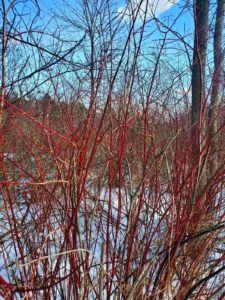by Kennedy Zittel, Naturalist Assistant
In winter, I am reminded of how much I enjoy seeing the beautiful colors that are plentiful in spring, summer, and fall. The greens of spring, flowers in summer, and color-changing leaves of fall. Winter is full of soft muted colors, but it is not nearly the same as the bright colors of the other seasons. Yet, I am also reminded each winter of how absolutely beautiful it is as well.
 Some of my favorite things to see in winter… how conifers stand out against leafless deciduous trees. How tracks in the snow show that people aren’t the only ones using our trails. When frost clings to goldenrod stems, looking like little bits of glass shining in the sunlight. When bird nests are visible in shrubs along the trails, once covered by leaves, showing how close their little homes were to us all along. When sunlight hits the blanket of snow on the ground, causing the snow crystals to sparkle like glitter. And how all of the colorful plants and animals stand out against the winter backdrop, giving us a bit of color in such a muted landscape.
Some of my favorite things to see in winter… how conifers stand out against leafless deciduous trees. How tracks in the snow show that people aren’t the only ones using our trails. When frost clings to goldenrod stems, looking like little bits of glass shining in the sunlight. When bird nests are visible in shrubs along the trails, once covered by leaves, showing how close their little homes were to us all along. When sunlight hits the blanket of snow on the ground, causing the snow crystals to sparkle like glitter. And how all of the colorful plants and animals stand out against the winter backdrop, giving us a bit of color in such a muted landscape.
Birds like cardinals, with their brightly colored feathers, are that color all year. Yet when we think of them, we think of winter… as their vibrant coloring stands out so much more now. One of my favorite things in winter, like cardinals, is colorful year-round, yet I grow to appreciate the color it provides much more in winter. And, like the cardinal, it is red.
If you walked on Willow Trail during any other season, you probably had many colorful things to look at. Leaves dancing overhead, birds moving amongst the branches, leopard frogs hopping across the trail, and flowers like bottle gentian, goldenrod, and milkweed lining parts of the trail. If you walk down Willow Trail this winter, I bet you would notice what I’m talking about right away, even though it has been there this whole time. The red of red-osier dogwood shrubs really stand out amongst the muted winter colors, lining Willow Trail with a beautiful pop of color.
Cornus sericea, the red-osier dogwood, is one of the 16 dogwood species native to North America. This shrub grows in areas with poorly drained soil, and is fond of wet areas. They are medium-sized shrubs, typically growing around 3-9 feet tall, and can grow into dense thickets. Here at Woodland Dunes, they are a common plant in the wet areas, such as along Willow Trail or out near the swales. While they are usually bright red in color, some may lack the red and look gray if they are in a really shaded area. They have white flowers that pollinators enjoy and white berries that many species of wildlife, including 47 species of birds, love to eat! Red-osier dogwood shrubs are great nesting habitat and form a great cover for wildlife. They are an important food for deer, especially in winter. They are often used to help stop erosion, especially along waterways. Due to their hardiness, tolerance of flooding, and ability to grow from cuttings, they make a great low-cost restoration plant.
Native people also appreciate red-osier, which is referred to as red willow. Makes sense as it grows in wet areas alongside several willow species. Its red bark is dried and processed, and is used to make kinnikinnick for ceremonial purposes along with other plants.
I hope that you can go out for a nice winter walk and see some of the beautiful things that winter has to offer. If you go out on Willow Trail, look for the red of the red-osier dogwood along the trail. See if you can see any tracks underneath them, as humans aren’t the only ones that enjoy being around them. Try and look for things that may go unnoticed during the other seasons like colorful lichen, fungi, and tracks too.
Photo of Red Osier Dogwood on Willow Trail by Kennedy Zittel
